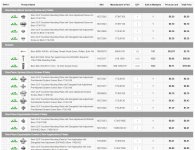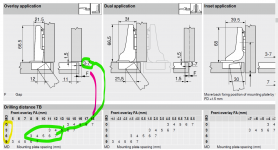The cruciform pages in the catalogue are kinda meh. Still worth taking a look though.
Your material and construction type will dictate the screw-type.
Crappy particleboard and MDF tend to steer towards the dowel types. If you're CNCing or want to do the LR32 on the mount holes, then you can choose the 5mm screw holes (listed as 6.1mm). Plywood and manual installs are going to be the #6 wood screws. Unfortunately, the 5mm system mounts are not interchangable with the other two options as they use larger holes. Although you can mount with a #7 screw if need be. The dowel types can be used with #6 screws. Just unmount the plastic dowels.
The offset amount, ie. 0mm 3mm 6mm or 9mm are from this table on page 75 from the catalog for the 110 hinge.
View attachment 1
Start on how you want the overlay (purple). FA is measured from the inside edge, not the F as in the diagram (but I highlighted the wrong one).
Then choose the least obnoxious MD (yellow) that'll let you still hit the range. This is the cruciform height.
Occasionally, sometimes your door construction may dictate how far you can shift that hinge cup (green) and limit which option you choose.
You can see that adding height to the cruciform lets you shift it inward. With the dual hinge type, you can thus choose to inset or overlay, or half overlay because it can span all options by changing cruciform.
Unless your min-maxing inventory, I'd avoid the dual though and just grab the appropriate hinge as need be. Some of the high cruciforms look kinda silly.
** Adding that dowel types do require some force to set the plate and hinges. They sell Blum hammer jigs but you can also just use a block of wood and be careful.


